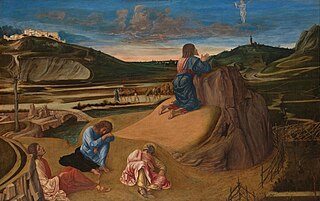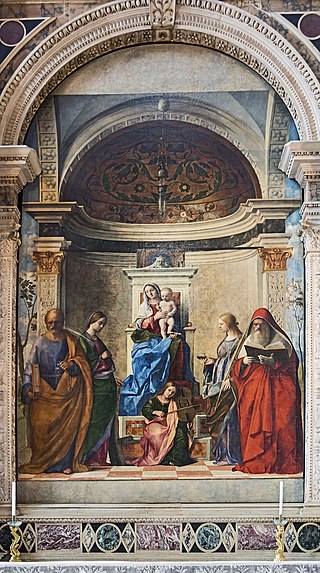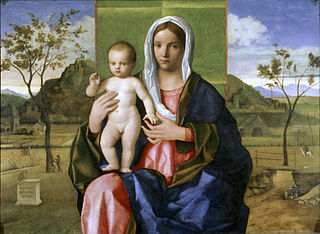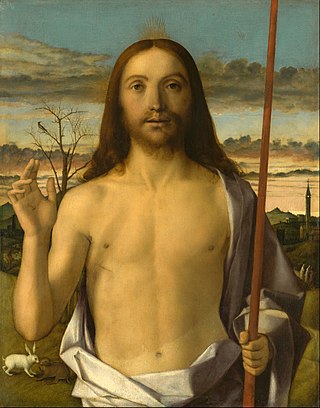
Giovanni Bellini was an Italian Renaissance painter, probably the best known of the Bellini family of Venetian painters. He was raised in the household of Jacopo Bellini, formerly thought to have been his father, but now that familial generational relationship is questioned. An older brother, Gentile Bellini was more highly regarded than Giovanni during his lifetime, but the reverse is true today. His brother-in-law was Andrea Mantegna.

Vittore Carpaccio (UK: /kɑːrˈpætʃ oʊ/, US: /-ˈpɑːtʃ-/, Italian: [vitˈtoːre karˈpattʃo]; was an Italian painter of the Venetian school who studied under Gentile Bellini. Carpaccio was largely influenced by the style of the early Italian Renaissance painter Antonello da Messina, as well as Early Netherlandish painting. Although often compared to his mentor Gentile Bellini, Vittore Carpaccio's command of perspective, precise attention to architectural detail, themes of death, and use of bold color differentiated him from other Italian Renaissance artists. Many of his works display the religious themes and cross-cultural elements of art at the time; his portrayal of St. Augustine in His Study from 1502, reflects the popularity of collecting "exotic" and highly desired objects from different cultures.

Marco Basaiti was a Venetian painter of the Renaissance who worked mainly in Venice and was a contemporary of Giovanni Bellini and Cima da Conegliano. He has been referred to by several names including Marco Baxaiti, Marcus Basitus, and Marcus Baxiti. There is little documentation on Marco Basaiti besides his painting signatures and a guild's ledger of 1530 that records him as a painter of figures.

The Pinacoteca di Brera is the main public gallery for paintings in Milan, Italy. It contains one of the foremost collections of Italian paintings from the 13th to the 20th century, an outgrowth of the cultural program of the Brera Academy, which shares the site in the Palazzo Brera.

The Adoration of the Magi or Uffizi Triptych is a group of three tempera-on-panel paintings by Andrea Mantegna, dating to around 1460. Their three subjects are the Ascension of Christ, Adoration of the Magi the largest and central panel and the Circumcision of Christ. They were gathered as a trio in the 19th century, although some art historians doubt that they were created as a triptych set as they are arranged. They are in the Uffizi Gallery in Florence.

The Agony in the Garden is an early painting by the Italian Renaissance master Giovanni Bellini, who created it ca.1459–1465. It is a tempera painting on panel and is now in the National Gallery, London.

The circumcision of Jesus is an event from the life of Jesus, according to the Gospel of Luke chapter 2, which states:
And when eight days were fulfilled to circumcise the child, his name was called Jesus, the name called by the angel before he was conceived in the womb.

Crucifixion is a painting by the Italian Renaissance painter Giovanni Bellini, created around 1455–1460. It is housed in the Museo Correr in Venice.

Marco Marziale was a Venetian painter from, known to have been active from 1492/93 to 1507. He was a pupil of Giovanni Bellini, as stated in some of his inscriptions signing works, and was also influenced by Giovanni's brother Gentile, with possibly some elements of the style of Perugino also. From January 1493, when he must have at least completed his training, he was employed by the Republic of Venice as an assistant to Giovanni Bellini on the Great Council Chamber in the Doge's Palace at a fairly modest salary. These paintings were all lost in the great fire of 1574. In 1493 he joined the confraternity of the Scuola di San Marco.

The San Zaccaria Altarpiece is a painting by the Italian Renaissance painter Giovanni Bellini, executed in 1505 and located in the church of San Zaccaria, Venice.

The Virgin Enthroned with Saints is a painting by the Italian Renaissance artist Luca Signorelli, dated to 1491 and housed in the Pinacoteca Comunale of Volterra, central Italy.

The San Giobbe Altarpiece is a c. 1487 altarpiece in oils on panel by the Venetian Renaissance painter Giovanni Bellini. Inspired by a plague outbreak in 1485, this sacra conversazione painting is unique in that it was designed in situ with the surrounding architecture of the church, and was one of the largest sacra conversazione paintings at the time. Although it was originally located in the Church of San Giobbe, Venice, it is now in the Gallerie dell'Accademia in Venice after having been stolen by Napoleon Bonaparte.

Pietà or The Dead Christ Supported by the Virgin Mary and St John the Evangelist is a c. 1465–1470 tempera-on-panel painting by the Italian Renaissance artist Giovanni Bellini, now in the Pinacoteca di Brera in Milan.

Lamentation over the Dead Christ is a c. 1500 tempera-on-panel painting by the Italian Renaissance master Giovanni Bellini kept at the Uffizi Gallery in Florence.

The Madonna and Child is a tempera-on-panel painting usually attributed to the Italian Renaissance artist Giovanni Bellini, dated to 1450–1460 or to 1450–1455 by Pignatti, though Olivari and others consider this to be too early. In the 1450s the painter was still heavily influenced by his father Jacopo and by Bartolomeo Vivarini. The strong line used for the Christ Child also shows the influence of Francesco Squarcione and his studio on the young Bellini. The general composition is based on a widely copied Byzantine icon in Venice, whilst the Christ Child holds a Flemish-style scroll bearing the artist's signature. The painting is closely linked to a similar work now in Philadelphia. It is now in the Pinacoteca Malaspina in Pavia.

The 'Madonna and Child or Madonna with the Christ Child Blessing is a 1510 oil-on-panel painting by the Italian Renaissance master Giovanni Bellini, painted when he was already in his eighties but still responding to new developments in painting. It is similar to the 1505 Madonna del Prato and the 1509 Madonna and Child. It is now in the Pinacoteca di Brera in Milan.

Christ Blessing is a tempera-on-panel painting by the Italian artist Giovanni Bellini. It is usually dated to the early 1460s, that is, in the middle of Bellini's Mantegnese phase. It is now in the Louvre in Paris.

Resurrection of Christ is a 1475–1479 painting by the Italian Renaissance artist Giovanni Bellini. It was produced for the Marino Zorzi chapel in the mortuary church of San Michele di Murano in Venice. It has previously been attributed to Cima da Conegliano, Previtali, Bartolomeo Veneto and Marco Basaiti. It was acquired by the Gemäldegalerie, Berlin in 1903 and a full restoration shortly afterwards confirmed its attribution to Bellini.

Baptism of Christ is a tempera painting on panel by the Italian Renaissance master Giovanni Bellini, dating to 1500–1502, and now located in the Chiesa di Santa Corona in Vicenza. It is signed IOANNES / BELLINVS on a rock in the lower left.

Christ Blessing is a painting by Italian Renaissance master Giovanni Bellini created around the year 1500.




















